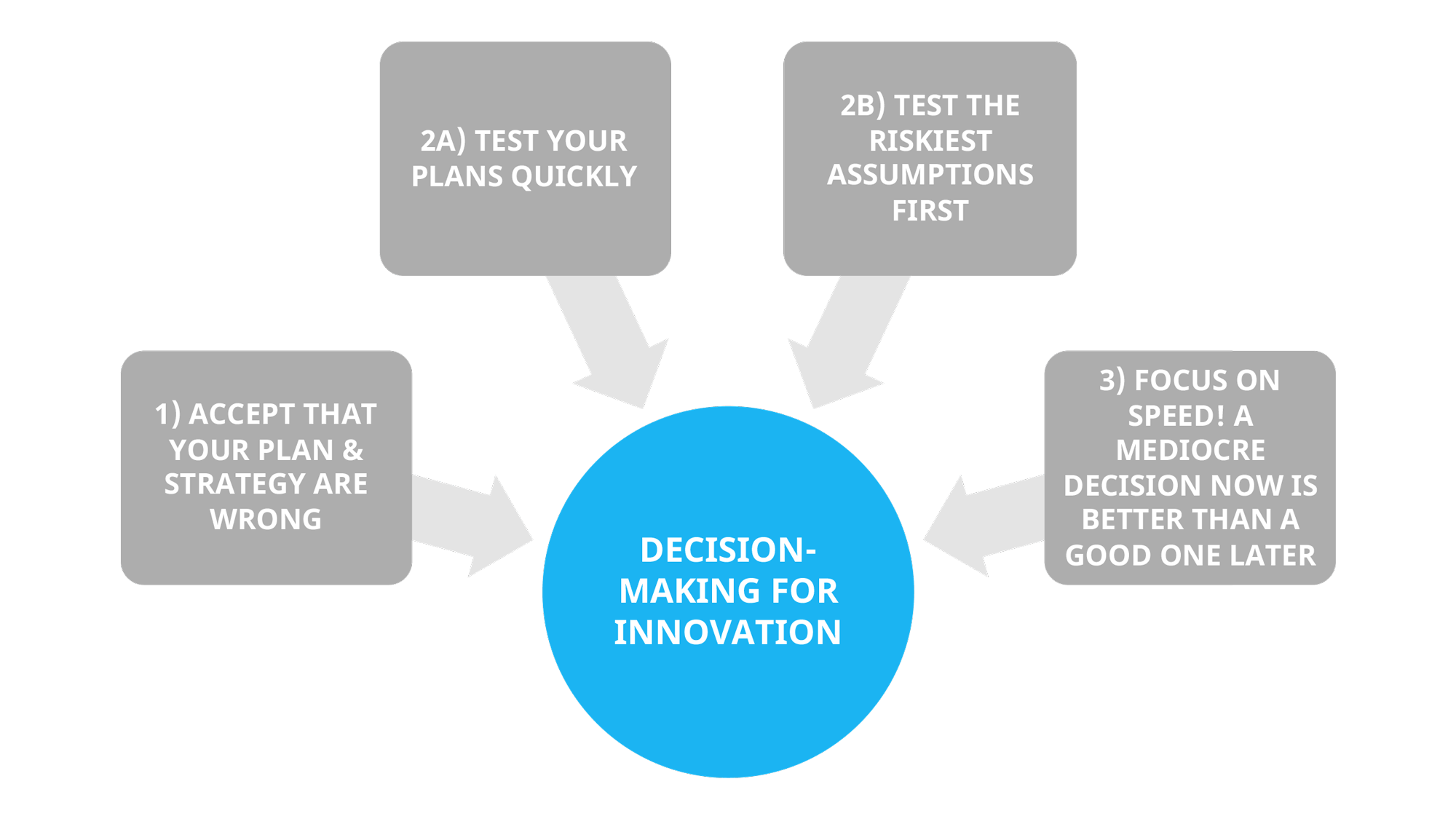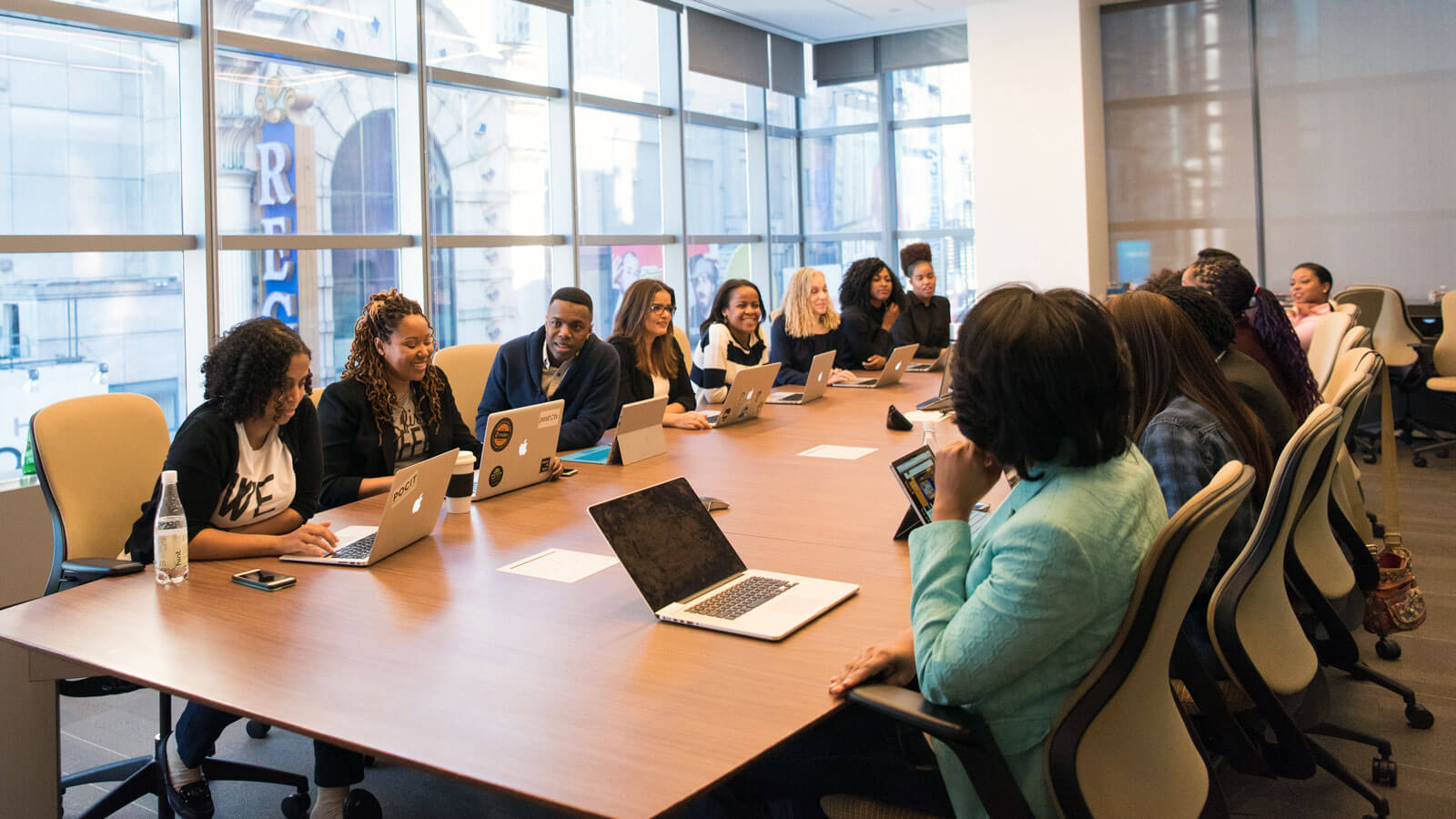The Art of Decision-making as an Innovation Leader
As we all know, innovating and creating something new is usually seen, for good reason, as an important, yet highly risky endeavor. As such, innovation leaders are constantly under a lot of pressure from many different directions.
Now, when we talk about innovation, we often focus on the more practical side of things related to the topic, such as processes, best practices, and tools. These are without a doubt all very important topics, but they still pale in comparison to decision-making.
If decision-making related to innovation is done poorly in an organization, none of the above will make a real difference. And, unfortunately, that is an area where we see many, perhaps even a majority of leaders and organizations struggle. But, while it is without a doubt difficult, it’s certainly not impossible.
So, today, we’ll be focusing on the art of decision-making as an innovation leader, specifically in medium and large organizations.
We’ll first explore some of the key challenges and misconceptions related to the topic to explain why so many leaders struggle with this, and then provide you with some more practical tools for sharpening your (or your bosses’) decision-making skills in the complex and unpredictable world of innovation.

Why is it so difficult to make smart decisions related to innovation?
Let’s first start by looking at the key characteristics of innovation.
- By definition, it’s about doing something new that hasn’t been done before. As such, there’s a lot of uncertainty and question marks related to almost every aspect of it.
- In many cases, you’re also working on solving challenges in a complex environment, which means that as things are interrelated with one another and thus it’s also difficult to predict what will happen.
- Because of the aforementioned, there usually isn’t much historical data to draw on.
- There aren’t reliable benchmarks or market size studies available either. And, because it’s all new, any data you may get from customer surveys and other similar methods likely won’t be reliable either.
- What’s more, your team hasn’t done this before, so you can’t create a very realistic project plan for implementing it either.
When you put all of that together, it’s a heck of a difficult environment to operate in, and for the most part, you just won’t have the data to make evidence-based decisions, or realistic plans, in advance.
How is this different from regular decision-making?
Let’s then dive deeper and compare decision-making on innovation with the context of “regular†decision-making in most organizations.
In any given organization, the majority of leaders have gotten to where they are because they’ve succeeded in what the business has been doing in the past. And since they have gotten to leadership positions, they obviously have a lot of responsibility for the company – and also a lot to lose on a personal level.
That obviously means that they want to make educated, evidence-based decisions that have as little risk as possible, and as much expected return as possible. They want to have a well thought out and structured plan for all of that in advance, then allocate resources accordingly and monitor progress compared to the plan closely while continuously improving the process.
And for good reason, not wanting to do that would just be reckless or plain stupid!
However, the problem is that because they’re used to operating in the existing business, they’re used to having lots of data, most of which is pretty reliable. There’s also a long track record of how people have performed in the given tasks, which helps in establishing realistic plans quite far into the future.
Well, as we’ve already established, for innovation, none of the above is possible, or at the very least, practically feasible!
Innovation is a completely different game, and to be able to succeed in it, leaders do really need to understand these fundamental differences between innovation and the traditional business, and then adjust their thinking accordingly.
That is, of course, easier said than done when you’ve had a lot of success working the other way for years or even decades.
The fundamentals for making great decisions on innovation
Now, all of that might sound like making smart decisions on anything innovation related is pretty much impossible.
The good news is that it isn’t, as long as you understand a few key fundamentals. These determine how decisions have to be made, and as long as you operate accordingly, the odds are that you’ll make the right decisions. That still doesn’t guarantee innovation success, of course, but it does go a long way in improving your odds of getting it right.

1. Accept that your strategy and business plans will always be wrong
The first, and most important thing is that you have to accept the fact that whatever innovation strategy or business plan you’ve created, it will always be either plain wrong, or at best, sub-optimal.
We’ve discussed the reasons for this above, but there’s a common saying in the startup world that sums it up quite nicely: “no business plan survives first contact with the customerâ€.
To recap, it’s important to understand that if you’re innovating, you’re always pushing the boundaries and exploring the unknown. As such, you’ll never be able to see everything clearly, nor have all the answers in advance. It’s just something that successful innovators have learned to live with and cope with.
You still need goals, and a strategy, and it still makes sense to have plans, but you just have to accept that they will have many flaws in them. As such, there’s no point in spending a lot of time trying to make them perfect. Focus instead on figuring out how they are wrong – and as quickly as possible. And the only way to do that, is naturally to put the plan into practice and see how it goes. This is the fundamental cornerstone that leads to our next key points: testing, learning, and speed.
This is the fundamental cornerstone that leads to our next key points: testing, learning, and speed.
2. Test your plan quickly – and start with the riskiest parts first to maximize learning
As we just discussed, once you accept that your plan will be wrong, the real job is no longer about ensuring that the plan is followed to the tee. It’s about testing whatever rough initial plan you have with the goal of learning which parts work, and more importantly, which ones don’t – and then adapting accordingly.
For many leaders, this might sound a bit unsophisticated and unscientific, but that’s actually not the case.
Let’s look back at what those of us who took a university degree learned: the scientific method. The whole idea is that you start with a theory or an assumption of the world, and then do field trials to test the assumption and analyze the results to see if it was correct. That is how you do cutting-edge research, and that is also how innovation happens, plain and simple.
So, as a business leader and decision-maker, remember that your strategy, as well as business and project plans are never more than hypotheses waiting to be tested. The real job, and the difference between those who fail and succeed will be your ability to adapt to whatever you learn – fast enough, and well enough. Now, the key to getting that right can be a bit counter-intuitive for many of us: we need to start from the riskiest assumption first.
Now, the key to getting that right can be a bit counter-intuitive for many of us: we need to start from the riskiest assumption first.
In most projects within an organization, it makes sense to try get some quick wins in first to get the ball rolling and win support for the project, but for strategy and innovation, that is usually problematic.
In many cases, this leads you to a false sense of success as you implement the trivial challenges while there’s still an existential challenge right around the corner.
The end result is that you do a lot of work and spend a lot of money only to figure out that the initial plan just won’t work without major changes to it once you encounter that existential challenge.
At that point, most of that hard work will just have to be thrown away, and you’ve also wasted a lot of time in the process. Or even worse, you might fall prey to the sunk cost fallacy and just keep going without a real chance of success.
On the other hand, if you start by testing the riskiest and most critical part first, you will likely struggle and fail at first, but soon get to a point where you understand the problem well enough to also be able to solve it the right way.
This will save you a lot of time and money down the road – and minimize the chance of the project becoming a hugely expensive failure.
For most businesses, the riskiest parts are typically related to customer demand, but there are also cases where this could be something different, such as technology.
For example, if you can come up with a super effective and affordable cure for all kinds of cancers, the rest is trivial. You’ll have plenty of demand, and it won’t be hard to build a great business out of that. In this case, you should go all in on solving the technical challenge and not worry about marketing, distribution channels and the like. On the other hand, in the 2020s, building the next social media platform is easy. You can do this as an individual with minimal or no prior coding experience and a minimal budget. The bigger question is if anyone will want to use that or pay for it. So, here it makes no sense to fine tune every aspect of the app and have it ready for a massive launch on all distribution platforms at once, if you don’t have strong proof of demand for what you’re doing.
On the other hand, in the 2020s, building the next social media platform is easy. You can do this as an individual with minimal or no prior coding experience and a minimal budget. The bigger question is if anyone will want to use that or pay for it. So, here it makes no sense to fine tune every aspect of the app and have it ready for a massive launch on all distribution platforms at once, if you don’t have strong proof of demand for what you’re doing.
3. Focus on speed – a mediocre decision now is better than a good one later
The third and final key to successful decision-making for innovation is to focus on the speed of the decision-making.
In many large organizations, decision-making tends to be pretty slow. It’s often beneficial to seek input from all parts of the organization on a potential decision and get them to ok the decision in advance to have less change resistance down the road – and to avoid having to take personal responsibility for bad decisions.
And since most decision-makers are super busy, it can take weeks, sometimes even months to get hold of all of them, and to then get them up to speed and provide them with enough information to be able to approve a decision, even if it would be a relatively simple one.
As mentioned, there’s of course value in doing that, but the problem is that even with all that input, the decisions will still often be wrong when it comes to innovation for the reasons we’ve already discussed. So, in the end, that value will be pretty marginal in the grand scheme of things.
However, the cost for this kind of slow, participatory decision-making is huge, both in terms of work time used by everyone, but also in terms of calendar time wasted. What’s more, innovations are almost always at least somewhat controversial, and if a consensus has to be reached, you will likely only end up with a worse, watered down version of the initial idea. When you combine that with the fact that many, if not most, initial decisions, just like business plans, will anyway be less than optimal due to the high uncertainty, it’s just much better to make a quick decision right now, even if it is wrong, than it is to try to get to a seemingly perfect decision later.
When you combine that with the fact that many, if not most, initial decisions, just like business plans, will anyway be less than optimal due to the high uncertainty, it’s just much better to make a quick decision right now, even if it is wrong, than it is to try to get to a seemingly perfect decision later.
If you move fast and decisively, you can usually make the decision, implement it and learn if it indeed was the right one in the time that it takes for some organizations to even make that decision. This is a key competitive advantage that is nearly impossible for the slower organization to overcome.
So, with innovation, always err on the side of action. Don’t wait for more information or more opinions, just get things done while making sure you’re moving in the right general direction, even if there are some details that you’ll need to figure out as you go.
Just by understanding and applying these three fundamentals in your decision-making, you will do better than most other organization.
However, the best innovation leaders do go beyond these fundamentals.
The art of deciding on the right things
As we’ve just established, innovation leaders need to be decisive, and to be able to make a lot of decisions quickly in an environment with a high level of uncertainty.
So, while it is important to be decisive, the uncertainty also means that you will need to be comfortable pushing some decisions down the road, thus leaving some open questions.
The skill that top innovators have mastered is their ability to figure out which of these to tackle now, and which ones to leave open. They ask the right questions and focus on making the right decisions, not just the questions and decisions you were presented with.
Top innovators ask the right questions and focus on making the right decisions, not just the questions and decisions you were presented with.
To explain what this means, let’s use a bit of an oversimplified example that’s not related to innovation per se, but that is one that we can all relate to:
You often hear people say how you can either work hard, or you can work smart, and that you should then decide which of these you want them to do.
The question is obviously a setup, because no one wants to “work dumbâ€, so from the options presented, all you can really do is to say to work smart. But that’s actually the wrong answer.
By just choosing one or the other, regardless of which one you choose, you’ll never get great results. To achieve those, you of course have to work BOTH hard and smart. The real question, then is: how can you change the system so that you don’t have to choose between one or the other, but can have both?
The real question, then is: how can you change the system so that you don’t have to choose between one or the other, but can have both?
So, as a leader, you must ignore these irrelevant choices that people often use as excuses for choosing the path of least resistance. Try to dig deeper and come up with answers to the questions that actually matter.
This is how real leaders and innovators think: they find ways to change the system so that they can get to the result they want.
This is how real leaders and innovators think: they find ways to change the system so that they can get to the result they want.
That is, of course, easier said than done!
However, the world is filled with situations and decisions like this where you have to choose between less-than-ideal alternatives. In some cases, you can just choose either one, but for the questions and problems that really matter, you can’t be satisfied with these mediocre, at best lukewarm, options and results.
The only way to get past these options, and achieve truly great results, is to ask the question that most people haven’t yet asked, or at least haven’t been able to solve.
Examples of misleading choices in practice
As mentioned, there are countless example of this in leadership and in innovation. Here are a few common ones:
- “Do you want this done properly (reliably, safely…), or do you want it done quickly?â€
- “Do you want incremental innovation or breakthrough innovation?â€
- “Do you want to lead by example or empower your team?â€
The answer to all of these questions is never one or the other, but always both. The exact balance between the two extremes will be different in every situation, but if you just choose one or the other, the bottom line is that results won’t be great.
Key takeaways
To conclude, working on innovation requires a different mindset than what most of us are used to. As such, it is often challenging for organizations to make smart decision related to innovation, and even if you could do that, you may have to change the perspectives of those around you as well.
This is a big reason for why a lot of people and organizations fail at innovation.
Remember, a mediocre decision now is always better than a good decision later – and make sure you focus on the decisions that actually matter, not the ones that people just send your way. This is what thinking outside the box actually means.
If you can succeed in changing your mindset and improving your decision-making skills so that you’re better prepared to tackle uncertainty and complexity, you’ll do great in innovation – and in life!
This article was originally published in Viima’s blog.
NEVER MISS ANOTHER NEWSLETTER!
LATEST BLOGS
Three things you didn’t know about credit cards
Photo by Ales Nesetril on Unsplash Many of us use credit cards regularly. From using them for everyday purchases to…
Read MoreFive CV skills of a business-minded individual
Photo by Scott Graham on Unsplash The skills listed on a CV help employers quickly understand your suitability for a…
Read More

